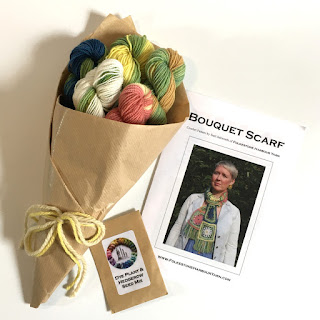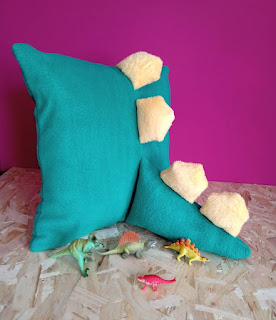Dye Plant Meadow/Hedgerow seed mix Information.
If you have purchased the special edition Wool Week 2020 Botanically Dyed 'Bouquet' mini skein set from Stem by Stem, Folkestone or www.FolkestoneHarbourYarn.com, you will find it includes a packet of native and naturalised wildflower plant seeds that can be used for natural dyeing. This blog post contains more information about growing and using your free seeds.
The seeds can be scattered over a small patch of broken ground, around 2m x 2m, if you have a wildflower area in a garden or allotment, otherwise you can cultivate the seedlings in pots and plant out once the first frost has passed. Even if you do not intend to use the plants for dyeing, they are still an interesting variety of plants beneficial to insects and pollinators.
For information about dyeing methods, you can find information on dyeing techniques online, in a variety of books available in bookshops, or elsewhere on this blog. These plants can be used with cotton, linen and wool, with varying results and methods for each fibre.
Woad (Isiatis Tinctoria)
Seeds look like: 15mm long black/yellow teardrop. Grown in Folkestone.
Plant looks like: 1st year - rosettes of lettuce/spinach like leaves close to the ground (note: not edible). 2nd year - produces tall (up to 6 foot) stems with sprays of tiny yellow flowers. Has a cabbagey smell.
Growing conditions: quite likes alkaline soil, so I add lime to the bed, which helps develop indigoferin (blue) pigment in the leaves. Drought resistant as has long tap roots. Will self seed in second year after producing spectacular 'clouds' of tiny yellow flowers.
Colours produced: Blue (from an indigo style vat), pinky browns (from leaves mashed and boiled).
Insects: leaves are quite popular with caterpillars of various species and slugs/snails. As you are not going to be eating woad yourself, its fine to let them munch a few leaves as this makes very little impact on the amount and quantity of blue pigment produced. Flowers are pollinated by insects so attracts all sorts of bees, butterflies and other winged insects in its second year.
Weld (Reseda Luteola)
Seeds look like: tiny black/brown rounds. Grown in Folkestone.
Plant looks like: tall shrub with long thin leaves and spikes of yellow/green buds. Can be 4-5 foot tall.
Growing conditions: needs very little care. Quite happy in dry or nutrient poor soils. Quite often seen growing on abandoned sites, but looks just as good at the back of a garden border.
Colours produced: Yellows, from whole plant fresh or dried. Best harvested in summer.
Insects: bumblebees, beetles, ladybirds. Our weld is next to the bird bath so provided some great post-spa snacks for our garden birds.
Corn Marigold (Glebionis Segetum)
Seeds look like: 2mm brown ridged pods.
Plant looks like: multiple large yellow daisy like flowers with bright yellow petals and centres, with many branches of toothed greeny-blue leaves. Grows up to 60 cm.
Colours produced: yellow through to olive brown.
Growing conditions: Grows easily almost anywhere, but prefers acidic soils. Hardy annual so will survive winter. Used to grow alongside cultivated corn fields, and until crop seed cleaning techniques were improved, was considered a major pest by farmers.
Insects: this plant is said to attract insects that feed on 'problem' garden pests such as aphids and nematodes. The ladybirds like it, and they certainly help keep aphids at bay. Hover flies, butterflies, moths, bees & other beetles also like this.
Tansy (Tancetum Vulgare)
Seeds look like: dark round centre with 'ruff' of dried yellow sepals. Grown in Folkestone.
Plant looks like: tight clusters of button like bright yellow flowers, fern like leaves. Grows up to 3 foot. Has a slightly bitter smell.
Growing conditions: very unfussy about soil types and is drought tolerant. However it does grow along riverbanks in Yorkshire and Norfolk where the small remaining populations of tansy beetles can be found. Watering encourages stronger yellow pigment. Puts potassium back into the soil. Fine with partial shade.
Colours produced; Bright yellows (from flower heads), greeny-yellow (from leaves & stems. Can be used fresh or dried. Deadhead flower clusters all summer long for
Insects: everything from bees to butterflies to ladybirds to lacewings & small beetles. The metallic green Tansy Beetle is one of the rarest insects in the UK, but we live in hope of seeing one!
Madder (Rubia Tinctorum)
Seeds look like: black peppercorns. Grown in UK.
Plant looks like: thin green stems with 'whorls' of star like leaves at regular intervals. Produces small yellow flowers in 2nd or 3rd year. Red/Orange pencil thickness roots are the source of colour, and can take a few years to produce enough dye pigment.
Growing conditions: quite likes loamy (sandy) soil as this helps the dye producing roots grow, and prefers sunny spots, but can grow in all soil types. Once established is virtually maintenance free. This plant will even tolerate seaside/salty conditions.
Colours produced: strong reds, pinks and oranges from roots. Plant tops have little colour but may produce light pinky-tan shades. Roots are best dug up in autumn. Needs gentle treatment to extract pigment. Heat slowly up to no higher than 60 degrees C.
Insects: ours attracted Hummingbird Hawk Moths this year- their caterpillars love this plant! All sorts of other creepy crawlies kept our dunnocks & blackbirds fed throughout the summer.
Yarrow (Achillea)
Seeds look like: tiny mustard yellow dots. grown in UK.
Plant looks like: Common wildflower. Grey green feathery leaves with wide, flat clusters of white-pink flowers. Grows about 2-3 foot tall.
Growing conditions: hardy perennial, likes good drainage and sun, although it can tolerate shade. Grows wild everywhere from roadsides to woods and meadows.
Colours produced: yellows & greens from flowerheads. Can be used fresh or dried.
Insects: anything that likes pollen!
If you have any more questions about your free seeds, please comment below or email via folkestoneharbouryarn@yahoo.com and I will do my best to answer your query.














Comments
Post a Comment